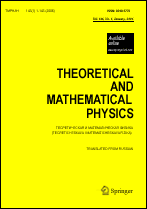|
This article is cited in 29 scientific papers (total in 29 papers)
Projective ring line encompassing two-qubits
M. Sanigaa, M. Planatb, P. Pracnac
a Astronomical Institute, Slovak Academy of Sciences
b CNRS — Institut FEMTO-ST, Département LPMO
c J. Heyrovsky Institute of Physical Chemistry
Abstract:
We find that the projective line over the (noncommutative) ring of
$2\times2$ matrices with coefficients in $GF(2)$ fully accommodates
the algebra of $15$ operators (generalized Pauli matrices)
characterizing two-qubit systems. The relevant subconfiguration consists of
$15$ points, each of which is either simultaneously distant or simultaneously
neighbor to (any) two given distant points of the line.
The operators can be identified one-to-one with the points such that their
commutation relations are exactly reproduced by the underlying geometry
of the points with the ring geometric notions of neighbor and distant
corresponding to the respective operational notions of commuting and
noncommuting. This remarkable configuration can be viewed in two principally
different ways accounting for the basic corresponding $9{+}6$ and $10{+}5$
factorizations of the algebra of observables{:} first, as a disjoint union
of the projective line over $GF(2)\times GF(2)$ {(}the "Mermin"
part{\rm)} and two lines over $GF(4)$ passing through the two selected
points that are omitted{;} second, as the generalized quadrangle of order
two with its ovoids and/or spreads corresponding to {\rm(}maximum{\rm)} sets
of five mutually noncommuting operators and/or groups of five maximally
commuting subsets of three operators each. These findings open unexpected
possibilities for an algebro-geometric modeling of finite-dimensional quantum
systems and completely new prospects for their numerous applications.
Keywords:
projective ring line, generalized quadrangle of order two, two-qubit.
Received: 12.12.2006
Revised: 20.03.2007
Citation:
M. Saniga, M. Planat, P. Pracna, “Projective ring line encompassing two-qubits”, TMF, 155:3 (2008), 463–473; Theoret. and Math. Phys., 155:3 (2008), 905–913
Linking options:
https://www.mathnet.ru/eng/tmf6223https://doi.org/10.4213/tmf6223 https://www.mathnet.ru/eng/tmf/v155/i3/p463
|


| Statistics & downloads: |
| Abstract page: | 1091 | | Full-text PDF : | 374 | | References: | 113 | | First page: | 3 |
|




 Contact us:
Contact us: Terms of Use
Terms of Use
 Registration to the website
Registration to the website Logotypes
Logotypes








 Citation in format
Citation in format 
